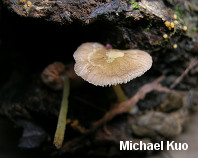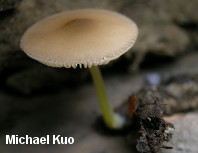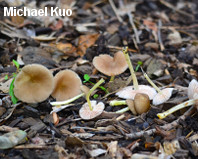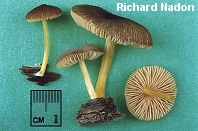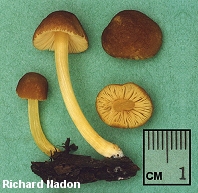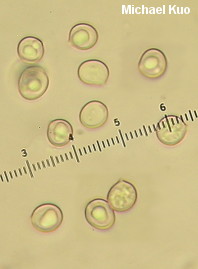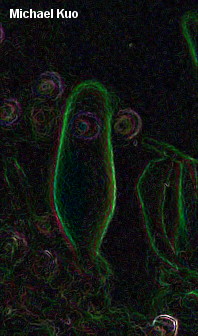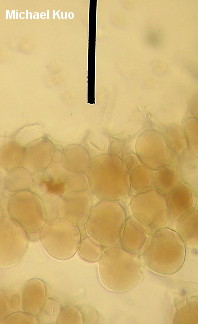| Major Groups > Gilled Mushrooms > Pink-Spored > Pluteus > Pluteus romellii |

|
Pluteus romellii [ Basidiomycota > Agaricales > Pluteaceae > Pluteus . . . ] by Michael Kuo Pluteus romellii, like all species of Pluteus, grows from wood and features gills that are free from the stem, along with a pink spore print. It is a fairly small species (the cap measures under 5 cm), identified by the color combination of a brown cap and yellow stem. In North America the species has gone under a variety of names, including Pluteus lutescens, Pluteus nanus var. lutescens, Pluteus fulvibadius, and Pluteus melleipes--but two recent studies (Minnis & Sundberg, 2010; Justo and collaborators, 2011) have, together, simplified things and allowed us to apply the European species name romellii to our North American collections. Description: Ecology: Saprobic on decaying hardwood logs and debris (especially in beech-maple forests); also found in woodchips in urban areas; growing alone or gregariously; summer and fall; widely distributed in North America. The illustrated and described collections are from Illinois, Kentucky, and Québec. Cap: 1-4 cm; more or less convex at first, becoming broadly convex or flat, often with a central bump; bald; not slimy or sticky, but with a greasy or almost waxy texture; somewhat wrinkled, especially over the center; dull brown to olive brown (often darker over the center); the margin becoming finely lined. Gills: Free from the stem or nearly so; close or nearly distant; short-gills frequent; whitish at first, becoming pink as the spores mature. Stem: 1.5-6 cm long; 1-3 mm thick; equal; fragile; bald, or with tiny fibers; bright yellow to greenish yellow (often brighter toward the base), at least when young; sometimes fading to whitish with a yellowish base; Odor and Taste: Not distinctive, or faintly radish-like. Spore Print: Pink. Microscopic Features: Spores 5-7 x 5-6 µ; broadly ellipsoid to sublacrymoid or subglobose; smooth; hyaline in KOH; inamyloid. Hymenial cystidia 40-55 x 10-15 µ; lageniform to subutriform or nearly cylindric; occasionally with a long neck; thin-walled; hyaline in KOH. Pileipellis a cystoderm; brown in KOH; elements subglobose, 20-38 µ across. REFERENCES: (Britzelmayr, 1891) Saccardo, 1895. (Kauffman, 1918; Singer, 1956; Homola, 1972; Smith, Smith & Weber, 1979; Arora, 1986; States, 1990; Vellinga, 1990; Breitenbach & Kränzlin, 1995; Roody, 2003; McNeil, 2006; Minnis & Sundberg, 2010; Justo et al., 2011; Kuo & Methven, 2014.) Herb. Kuo 09300403, 05311503. This site contains no information about the edibility or toxicity of mushrooms. |
© MushroomExpert.Com |
|
Cite this page as: Kuo, M. (2015, May). Pluteus romellii. Retrieved from the MushroomExpert.Com Web site: http://www.mushroomexpert.com/pluteus_romellii.html |
